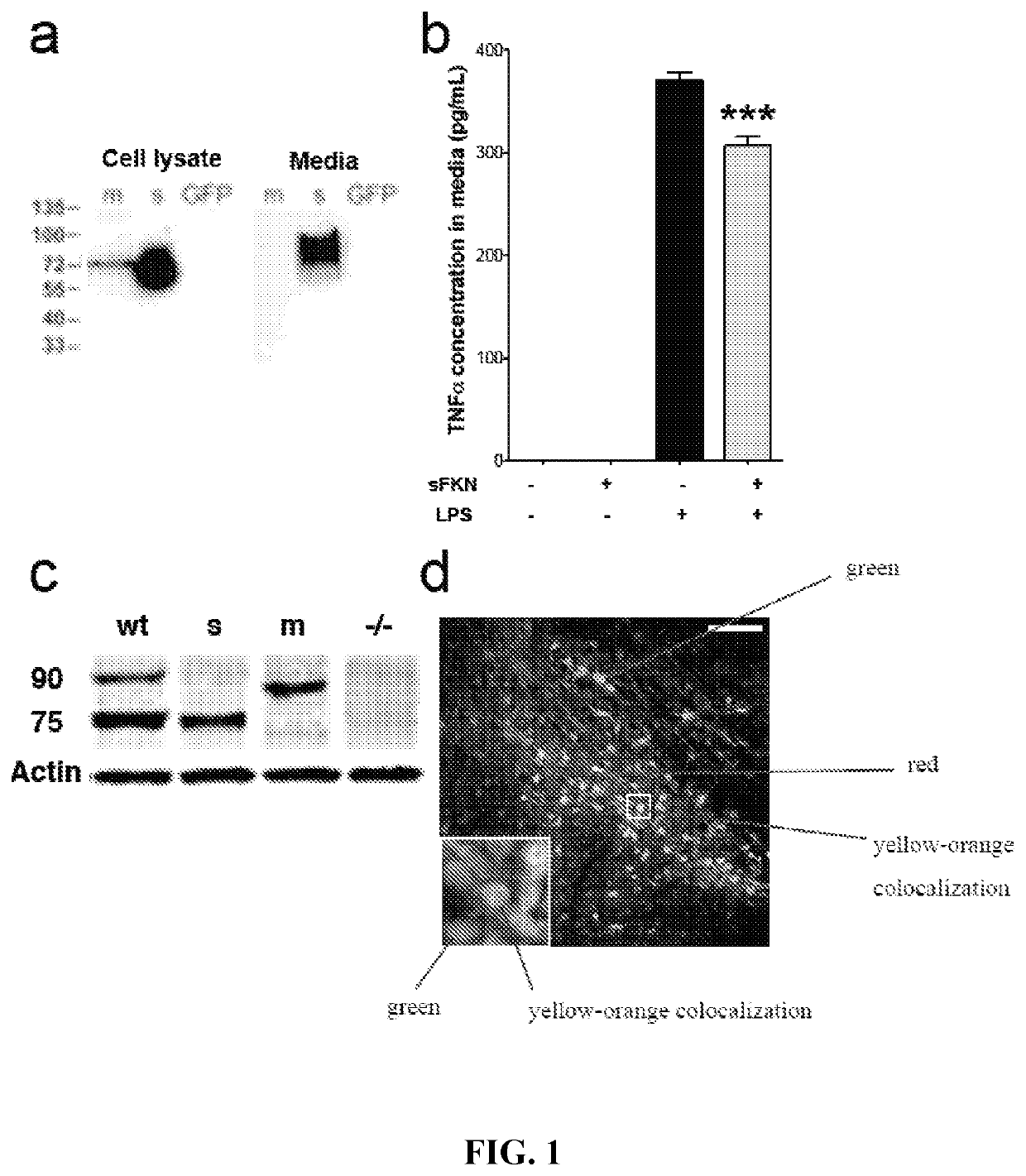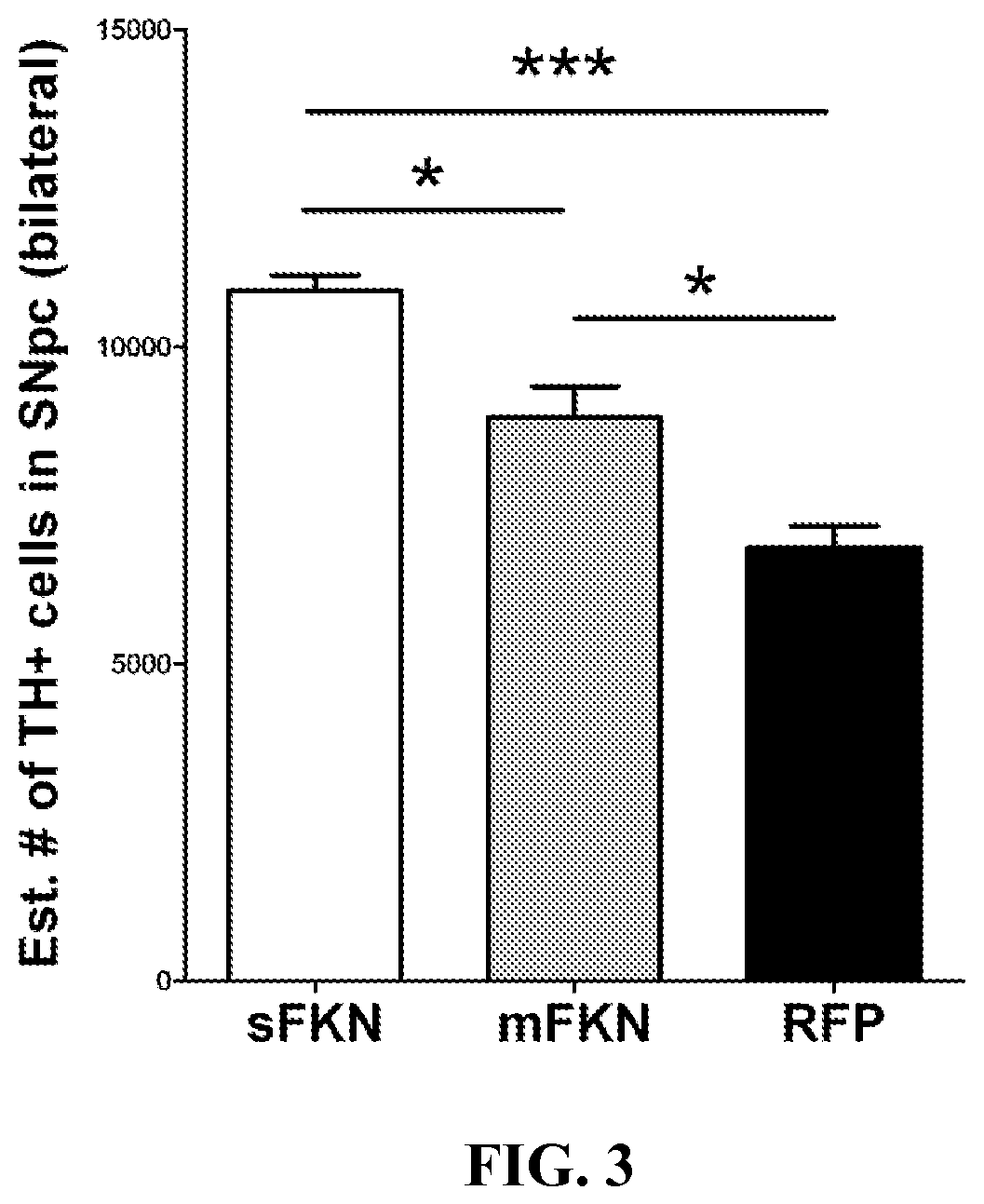Recombinant adeno-associated virus-mediated expression of fractalkine for treatment of neuroinflammatory and neurodegenerative diseases
a technology of fractalkine and adenovirus, which is applied in the direction of peptide/protein ingredients, genetic material ingredients, peptides, etc., can solve the problems of muscle rigidity, motor system, motor coordination and speed impairment, etc., to prevent and/or reduce the loss of synuclein nigral neurons, and the effect of treating or ameliorating neuroinflammatory and neurodegenerative diseases
- Summary
- Abstract
- Description
- Claims
- Application Information
AI Technical Summary
Benefits of technology
Problems solved by technology
Method used
Image
Examples
example 1
ective Effects of AAV-Mediated Transfer of Fractalkine
[0115]This Example shows that increased FKN expression in the brain region via rAAV-based gene therapy has neuroprotective effects. To examine the therapeutic effects of FKN, FKN is over-expressed using rAAV and cell-specific promoters. Adeno-associated viruses have been used as vectors for gene therapy. rAAV serves as an excellent vector for gene delivery into the CNS. rAAV is non-pathogenic and has low immunogenicity. In addition, all viral genes can be removed from recombinant AAV virus, and long-term expression is attainable.
[0116]Three forms of mouse FKN constructs are made and amplified by PCR: 1) the native form (SEQ ID NO:6) (nFKN, which can form both soluble and membrane-bound forms after subsequent processing), 2) the soluble domain of FKN (sFKN) (SEQ ID NO:7), and 3) a protease resistant mutant membrane-bound form (mFKN) (SEQ ID NO:8). To facilitate in vivo detection, hemaggluttinin (HA) tags are attached to the FKN co...
example 2
ion of Neuronal Cells Using Recombinant AAV9-FKN Vectors
[0122]Both the soluble form and the membrane-bound mutant rAAV9-FKN are produced using a murine version of the CX3CL1 gene driven by the hybrid chicken β-actin cytomegalovirus promoter and are tagged with hemagglutinin (HA) peptide sequence for ease of detection. Prior to virus production, the rAAV vector is tested in HEK293 cells to evaluate sFKN and mFKN proteins are produced from the expression cassette. Cell lysate and conditioned media from transfected cells are examined using Western blot analysis to determine sFKN and mFKN expression. An anti-HA tag Western blot analysis of transfected HEK 293 cells reveals that sFKN is secreted into the media, while mFKN remains only in the cell lysate fraction (FIG. 1a).
[0123]The synthetic FKN proteins are biologically active. Briefly, conditioned media from HEK 293 cells transfected with the sFKN plasmid are used to confer bioactivity by measuring the amount of secreted TNF-α from BV2...
example 3
of MPTP-Induced Impairment of Motor Coordination by the Soluble Isoform of FKN
[0125]The effects of rAAV-sFKN and rAAV-mFKN on MPTP-induced motor deficits are examined using an accelerating rotarod. FKN− / − Sham mice display no motor coordination impairment when compared to WT-Sham (FIG. 7). Five days after the last MPTP injection, all MPTP-treated groups display a significant trend for performance impairment (F (1, 145)=42.11, p<0.001), as measured by average latency to fall across three trials compared to WT-Sham mice (FIG. 7). Treatment with sFKN significantly improves MPTP-induced behavioral deficits when compared to mFKN (p=0.002) and GFP (p<0.001) viral control.
[0126]Following rotarod performance assessment, mice are sacrificed and striatal tissues are dissected for biochemical analysis. Consistent with each group's rotarod performance, Western blot analysis reveals a significant loss of striatal tyrosine hydroxylase (TH) as a result of MPTP administration (p<0.001), ranging fro...
PUM
| Property | Measurement | Unit |
|---|---|---|
| diameter | aaaaa | aaaaa |
| time | aaaaa | aaaaa |
| distance | aaaaa | aaaaa |
Abstract
Description
Claims
Application Information
 Login to View More
Login to View More - R&D
- Intellectual Property
- Life Sciences
- Materials
- Tech Scout
- Unparalleled Data Quality
- Higher Quality Content
- 60% Fewer Hallucinations
Browse by: Latest US Patents, China's latest patents, Technical Efficacy Thesaurus, Application Domain, Technology Topic, Popular Technical Reports.
© 2025 PatSnap. All rights reserved.Legal|Privacy policy|Modern Slavery Act Transparency Statement|Sitemap|About US| Contact US: help@patsnap.com



